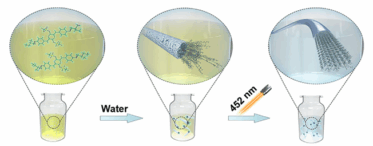Scientific Achievement

A method to perform topochemical polymerization (TCP) without degradation using X-Rays, including in a liquid medium.
Significance and Impact
This work uncovered the mechanisms of TCP using X-rays, developed a new strategy for controlling TCP synthesis. It opens a new pathway for cost-effective polymer manufacturing.
Research Details
- The researchers used X-rays to simultaneously transform and characterize single-crystal monomers in real-time, without degradation.
- They explored TCP transformations in powders, thin films, and a liquid medium, creating polymer nanofibers with high crystallinity.
- They also developed a strategy for controlling TCP pathways by modifying electron density in the AQM system’s aromatic end groups.
Yang, C., Liu, J., Khoo, R., Abdelsamie, M., Qi, M., Li, H., Mao, H., Hemenway, S., Xu, Q., Qang, Y., Zhang, Q., Liu, X., Klivansy, LM.,Gu, X., Zhu, C., Reimer, J.A., Cui, G., Sutter-Fella, CM., Zhang, J., Ren, G., Liu, Y. Nat Comm. 16, 3498. (2025) DOI:10.1038/s41467-025-58822-2
Zhang, Q., Pei, Z. … Zhang, J., Coote, M.L., Liu, Y., JACS 147, 17 (2025) DOI: 10.1021/jacs.5c03077
Research Summary
Topochemical polymerization (TCP) represents a powerful method for creating crystalline polymers directly from solid-state monomers without expensive solvents or catalysts. This unique approach opens new possibilities for polymer synthesis that would be difficult or impossible to achieve through conventional liquid-phase methods with the added benefit of minimizing waste, reducing energy consumption, and providing pathways for polymers that leverage bio-based resources. However, TCP’s solid-state nature presents significant challenges. Achieving precise polymerization states—where crystals transform while maintaining their structure and chemical composition—can be tricky. The delicate crystals can easily disintegrate when treated with heat, light, or pressure, which makes them difficult to study. As a result, the mechanisms by which monomers are polymerized during TCP remain largely hidden.
In a series of breakthroughs published in Nature Communications and the Journal of the American Chemical Society, a team of researchers has overcome these obstacles. They successfully used X-rays to simultaneously transform and characterize single-crystal monomers in real-time, without degradation. This body of work uncovers the complex mechanisms of TCP and paves the way for cost-effective polymer manufacturing. By utilizing the power of X-rays, researchers can achieve more precise polymer transformations, including versatile aromatic systems, and open new avenues for developing advanced polymers without using expensive solvents and catalysts.

